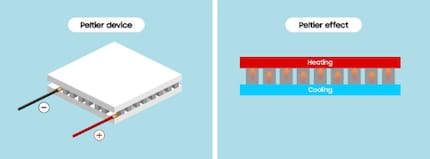
Samsung develops cooling technology without refrigerant
Together with Johns Hopkins University, Samsung is developing a technology for refrigerators that is based on the Peltier effect and does not require refrigerants. The new thin-film semiconductor technology is said to achieve around 75 per cent higher cooling performance than previous elements.
Classic refrigerators work with compressors that compress and vaporise refrigerant gas. Refrigerants are criticised because many of them are harmful to the climate. This is where Peltier cooling comes into play: it utilises a thermoelectric effect. An electric current flows through two semiconductor layers, causing one side of the element to absorb heat while the other side releases the heat.
The Peltier effect is already being used commercially in smaller cool boxes. However, the technology has so far been less efficient than compressor-powered cooling units. Peltier elements require more energy to reach the same temperature. This is set to change in the future.
Samsung sees a breakthrough in thin-film technology
Since Peltier cooling involves simultaneous heat absorption and heat generation on opposite sides of the component, the company developed special thermal interface materials and assembly techniques to better isolate the two processes for efficient heat transfer.
First hybrid models already on the market
Samsung launched its first model on the market last year, the «Bespoke AI hybrid refrigerator», which combines both cooling principles. Similar to hybrid vehicles, the system switches between compressor and Peltier module depending on the situation. During normal use, the compressor runs, while the Peltier element is additionally activated during high loads or when defrosting.
According to Samsung, the hybrid reduces power consumption by up to 30 per cent compared to conventional appliances. However, the new thin-film technology is not used in this first model.
Dispensing with refrigerants brings environmental benefits
Conventional refrigerants can damage the ozone layer when released and contribute to global warming. Hydrofluorocarbons (CFCs) and their successors have a negative impact on the greenhouse effect. This is why the EU has already introduced limits for the global warming potential of refrigerants, which will be tightened further by 2030. Samsung's development therefore also serves to keep the company in the game.
The company is currently working on integrating the new thin-film technology into upcoming series appliances. However, a short-term market launch has not been announced and is not expected. In my view, however, the development is an important step towards the complete elimination of refrigerants.
Hamburg local, bookworm, and ice hockey fan. Dad and granddad. Constantly tinkering around with my smart home setup. I love DIY, the outdoors, fashion, and cosmetics.
From the latest iPhone to the return of 80s fashion. The editorial team will help you make sense of it all.
Show all